Expand Your Harmonic Arsenal – Practice Cycles For Secondary Dominants
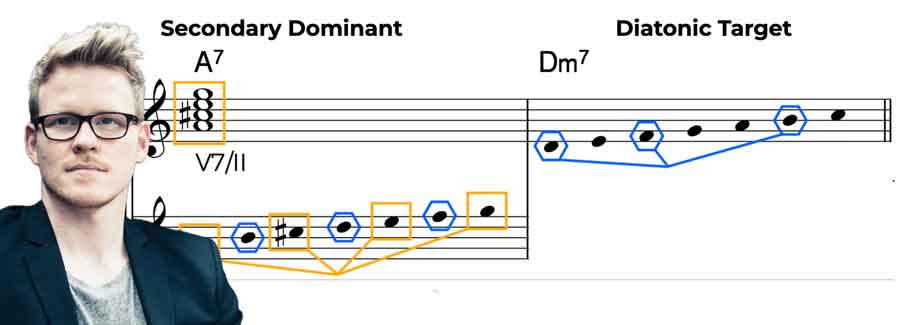
Secondary dominants play a crucial role in harmony theory, especially in jazz improvisation. They add richness and excitement to diatonic progressions, while expanding the possibilities of cadential harmony. To explore this important concept effectively in the context of jazz improvisation, I have designed a series of chord progressions. Each progression incorporates all secondary dominants, offering a concentrated practice tool for mastering these harmonies. Before diving into the progressions, we’ll first take a brief look at the theoretical background to better understand the underlying principles at work.
What Are Secondary Dominants?
“Secondary dominants are dominant chords that create an expectation of resolution down a fifth to a diatonic target“ (Mulholland & Hojnacki, 2013, p. 51).
They are used in many Jazz standards and popular chord progressions. Good examples are the “Turnaround“ or variations of the II-V-I progression:
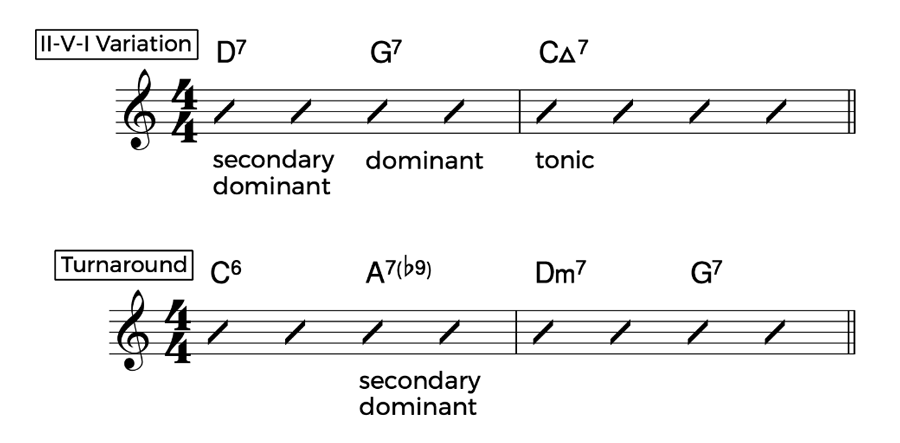
Diatonic System
To understand the concept of secondary dominants, it is necessary to examine the diatonic system. Let’s look at the diatonic system in C major with its diatonic chords, the corresponding functions (in roman numerals) and the associated modes:
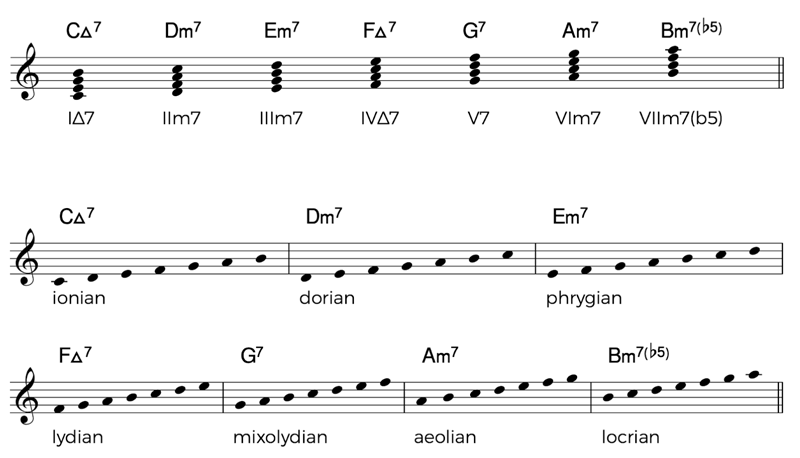
Secondary Dominants
Let’s now place a dominant seventh chord in front of every diatonic scale chord within C major:
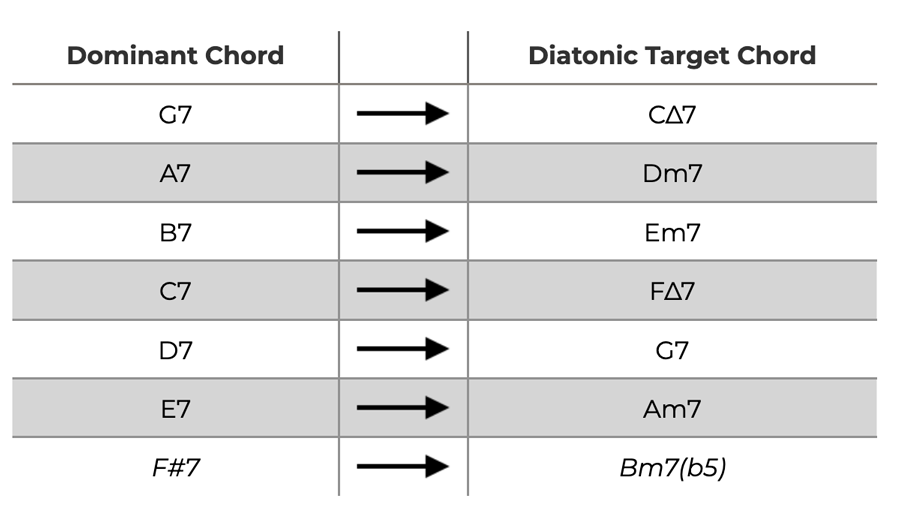
In the key of C major, G7 is the primary dominant, resolving to the tonic (G7 to C∆7). All other dominant chords are considered secondary dominants because they resolve to diatonic chords other than the tonic. The dominant of the seventh degree (F#7 to Bm7b5) is rarely used in practice and can generally be disregarded. Some theory books further specify that the root of a secondary dominant must also be a diatonic note from the underlying scale. This rule excludes F#7, as F# is not a diatonic note in C major. As a result, there are five secondary dominants within the major scale.
Scales For Secondary Dominants

Constructing the corresponding scales for secondary dominants is done by a simple step. To the given chord tones of the dominant, we add notes that derive from the mode of the diatonic target chord to which the dominant would naturally resolve.
Example: A7 to Dm7 within C major

Although this is a straightforward method for finding the corresponding scale, constructing scales for secondary dominants can be simplified even further in diatonic contexts. The scale is built using the chord tones of the dominant and the diatonic tensions from the original key. In other words, any additional tones or tensions to the chord tones are always derived from the underlying source scale.
The Approach Taken by the Masters
If you transcribe great players like John Coltrane, Sonny Rollins or Mary Lou Williams you’ll notice that they often use mixolydian (b9,b13) over V7/II instead of mixolydian (b13). This feels very natural and sounds very smooth for our ears. Having that in mind we can simplify the scales even more. All secondary dominants that resolve to a diatonic:

For secondary dominants to major chords, use the mixolydian scale. For secondary dominants to minor chords, we use mixolydian (b9,b13).
V7 to major → mixolydian
V7 to minor → mixolydian (b9,b13)
The Cycles
As mentioned earlier, I’ve developed various chord progressions that incorporate all secondary dominants within a harmonically coherent cycle. Below is one such cycle, along with its functional harmony analysis and a corresponding scale syllabus.
Cycle #1
Chords in Bb Major
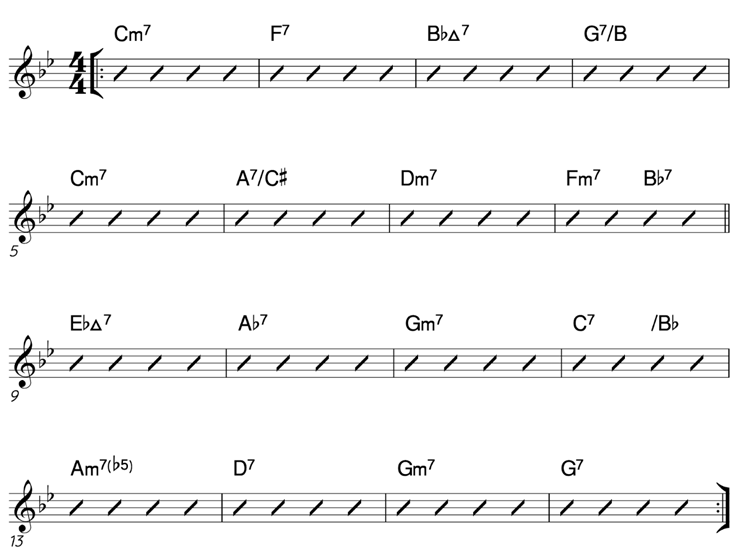
Functions
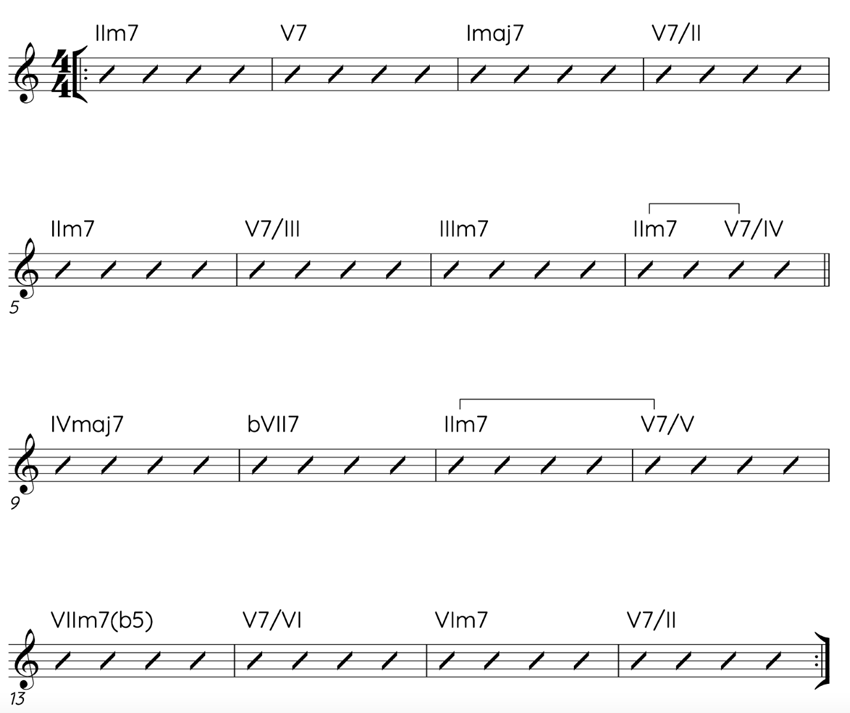
Scale Syllabus
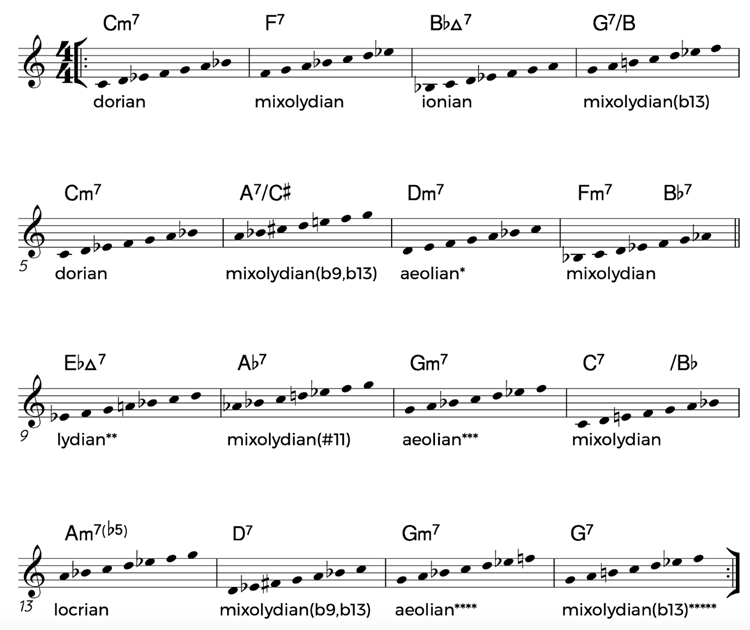
* Aeolian is played here instead of Phrygian. Try both and listen for the difference.
** Lydian is the right scale if you see this chord as the subdominant of Bb. Because of the preceding II-V one can also use Ionian as corresponding mode.
*** Dorian would also be an option here, if Gm7 is interpreted as IIm7 related to the following C7 dominant chord.
**** Can be Aeolian or Dorian. Let your ear decide.
***** Mixolydian(b13) is technically correct. In my opinion mixolydian(b9,b13) sounds much smoother and is used by many great jazz players in this kind of progression.
How To Work With The Cycles?
The secondary dominant cycles provide an exercise structure for your daily routine. In principle, any type of melodic, harmonic or rhythmic exercise can be applied to these cycles. They serve as a creative starting point and should help you to utilise your practice time effectively. Here are some ideas and possibilities for creative use:
- Learn the cycle by heart. Memorize the chord progression, functions, and associated modes.
- Transpose the cycle to all 12 keys. Practice every key individually or change keys every chorus.
- Practice the chord progression on the piano (if you are not a piano player).
- Limit your improvisation material, e.g. use only chord tones to improvise.
- Compose a melody to the given changes.
- Write down a solo over the cycle.
- Change the time signature. You can change it to any time signature you want and practice odd meters or mixed meters with these cycles as well.
- Practice in smaller loops (e.g. only 4 bars). Change the tempo and/or play the changes in half time or double time feel.
- Use and alternate different practice tools – metronome, playalongs, drum grooves etc.
- Create your own cycle for secondary dominants.
Further Suggestions
Popular Standards with Secondary Dominants
- All of Me (Gerald Marks)
- Body and Soul (Johnny Green)
- But Not for Me (George Gershwin)
- East of the Sun (Brooks Bowman)
- I’ll Be Seeing You (Sammy Fain)
- It Could Happen to You (Jimmy Van Heusen)
- On the Sunny Side of the Street (Jimmy McHugh)
- Someday My Prince Will Come (Frank Churchill)
- There Will Never Be Another You (Harry Warren)
- Without a Song (Vincent Youmans)
- You’ve Changed (Carl Fischer)
Literature List
- Crook, Hal: Ready, Aim, Improvise! Exploring the Basics of Jazz Improvisation (Advance Music)
- Jaffe, Andy: Jazz Harmony (Advance Music)
- Mulholland, Joe & Hojnacki, Tom: The Berklee Book of Jazz Harmony (Berklee Press)
- Sikora, Frank: Jazz Harmony, Think – Listen – Play – A Practical Approach (Schott)
For more details and additional cycles, refer to my book Micro-Studies #001 – Practice Cycles for Secondary Dominants (Melax Music). The book includes three more unique cycles, each featuring distinct chord progressions that demonstrate the role of secondary dominants in various harmonic contexts. It also offers guidance on practicing in all 12 keys and presents an etude that creatively incorporates dominant scales. Playalongs in iReal and MP3 formats are provided for each cycle to support your practice.www.melaxmusic.eu





